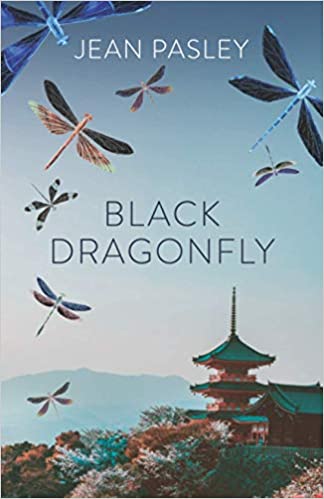(Balestier Press, 2021)

Black Dragonfly is a book of rich imagination, inspired by and incorporating the work of Patrick Lafcadio Hearn (1850 – 1904). Hearn, of Greek-Irish heritage, spent the last 14 years of his life in Japan, recording aspects of Japanese life that he found beguiling and at times bewildering. The 14 books, and numerous newspaper articles and lectures he produced, captured a period of rapid change and have been a source of influence, delight and debate ever since. Jean Pasley draws on Hearn’s time in Japan to offer insights into his character and inner thoughts. In doing so she weaves in earlier, at times traumatic, experiences in Europe, the USA and the Caribbean that helped shape him as a person. A masterful blend of fact, fiction and feelings, Black Dragonfly takes storytelling to another level.
The nature of the man who was Hearn has intrigued writers almost as much as his writing, perhaps more. Black Dragonfly joins two recent novels where the authors explore Hearn’s complex and enigmatic character from differing angles. Roger Pulvers (2011), in The Dream of Lafcadio Hearn, tries to answer the question of why Hearn found solace for his imagination and respect for himself only in Japan, as well as what it means to be a foreigner in any land, in any era. The story is written from a first-person perspective. In contrast Monique Truong (2020), in her book The Sweetest Fruits, envisions Hearn’s storied life from the viewpoint of his Greek mother and American and Japanese wives. Jean’s novel takes readers on a different and distinctive journey. It is a love story at heart, bringing to the fore Hearn’s relationship with Koizumi Setsuko whom he married in Matsue, Japan in 1891. This partnership changed his life immeasurably.
Poetic references to singing insects and dragonflies appear throughout Jean’s novel. Her evocative language is captivating. For example, on page 96, “The spectrally slender Emperor dragonfly was the most beautiful. It gleamed with indescribable metallic colours”. Hearn was intrigued by the beauty, sound and symbolism of insects; they were one of the many unfamiliar aspects of Japanese culture he observed and wrote of. The black dragonfly of the novel’s title is associated with both life and death, a reminder to make the most of each day. It is also used as a metaphor for the importance of having children in a land where ancestor-worship is deeply embedded. Family is central to the novel, with Lafcadio – who formally changed his name to Koizumi Yakumo – and Setsuko having four children before his death aged 54. Their descendants have been instrumental in keeping the Hearn/Koizumi legacy alive.
Hearn’s stories and impressions of the numerous countries he lived in makes him identifiable to, and scrutinised by, many people. His unique depictions of traditional Japanese culture continue to be of great appeal, especially the spiritual and supernatural elements. Collaborations between Japan, Greece, Ireland and the USA have flourished in the last decade through the creation of museums, memorials (including a biographical garden), exhibitions, symposiums, publications and artistic/philosophical ventures. Black Dragonfly adds a new and compelling perspective to the resurgent interest in Hearn’s life and works. Jean’s portrayal captures his nuanced and multi-layered character, that of an outsider, through engaging, elegant prose and immersive historical fiction.
